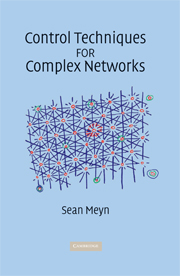Book contents
5 - Workload and Scheduling
from Part II - Workload
Published online by Cambridge University Press: 17 March 2011
Summary
Chapter 4 touches on many of the techniques to be developed in this book for controlling large interconnected networks. The fluid model was highlighted precisely because control is most easily conceptualized when variability is disregarded. The infinitehorizon optimal control problem with objective function defined in (4.37) can be recast as an infinite-dimensional linear program when c is linear. In many examples, such as the simple re-entrant line introduced in Section 2.8, a solution is explicitly computable. The MaxWeight policy and its generalizations are universally stabilizing, in the sense that a single policy is stabilizing for any CRW scheduling model satisfying the load condition ρ• < 1 along with the second moment constraint E[∥A(1)∥2] < ∞.
What is missing at this stage is any intuition regarding the structure of “good policies” for a network with many stations and buffers. In this chapter we introduce one of the most important concepts in this book, the workload relaxation. Our main goal is to construct a model of reduced dimension to simplify computation of policies, and to better visualize network behavior.
In the theory of optimization, a relaxation of a given model is simply a new model obtained by removing constraints. In the case of networks there are several classes of constraints that complicate analysis:
(i) The integer constraint on buffer levels.
(ii) Constraints on the allocation sequence determined by the constituency matrix.
(iii) State space constraints, including positivity of buffer levels, as well as strict upper limits on available storage.
- Type
- Chapter
- Information
- Control Techniques for Complex Networks , pp. 145 - 194Publisher: Cambridge University PressPrint publication year: 2007

